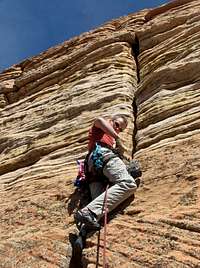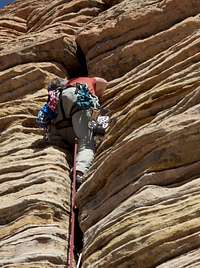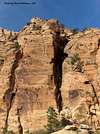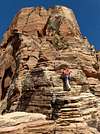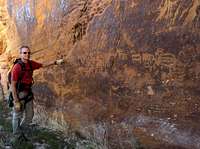-
 22925 Hits
22925 Hits
-
 87.76% Score
87.76% Score
-
 25 Votes
25 Votes
|
|
Route |
|---|---|
|
|
37.19800°N / 113.03°W |
|
|
Trad Climbing |
|
|
Spring, Summer, Fall, Winter |
|
|
Most of a day |
|
|
5.7 (YDS) |
|
|
III |
|
|
Overview/Approach
Cowboy Ridge is a 3300’+/- net elevation day and over 4000’ total gain in up and down elevation according to my altimeter. After Climbing Magazine did a spread (Earth, Wind and Rubble) on the alpine ridge climbs of Zion, I was contacted almost immediately by several friends and partners who wanted to jump on these “anything but alpine” ridges. Cowboy Ridge is most easily viewed from Rockville on your way to Springdale, UT but also dominates the western skyline of Springdale along with West Temple. Cowboy Ridge is aptly named as it is a wild and loose ride in Zion National Park.
As with most objectives in Zion, on approach you have the distinct advantage of being able to view and study your objective compared to true alpine environs, but you will pay a price if you are not watching your step. There is no distinct trail to the southern end of Cowboy ridge and the cacti are quite tenacious and abundant. You no doubt won’t be packing an alpine axe, crampons, etc, but instead will be lugging a minimum of three liters of water and if you are smart probably four.
Turn left onto Serendipity in Springdale. This is a privately maintained residential road and there might be access issues. I know one of the residents on this road and thus did not have to investigate access. It might be wise for you to do so if you use this approach. Follow Serendipity to the left as it forks and ride up a hill to a dead end where there is an empty lot on the right (2007) to park.
Route Description
We found no marked trail and just aimed for the highpoint of Cowboy Ridge which, despite what many think, is not the actual summit of Kinesava. There is a separate rock band that protects the lower flank of the ridge. The quickest access through this rock band is to stay right and hike a rubble strewn soft ridge up to the top of the cliffs. There is some resemblance of a trail up this ridge. Once through the cliff band however the trail peters out. Turn immediately left and follow the top of the cliff band. If you continue up and straight, you will have to lose elevation unnecessarily to access the south end of Cowboy Ridge. Continue parallel to Cowboy Ridge until you are forced to dip down into a drainage. At this point go ahead and ascend to the base of Cowboy Ridge and look for a wide break (ramp) that you can use to access the ridge without having to circle around to the very south end itself. There is a truck sized round boulder resting precariously on top of the ridge where this ramp is located. You are looking to take the ridge to the immediate right of this boulder. Once on the ridge, you will have approximately 2000’+/- left to go.
Following the ridge is extremely obvious, again, unlike being stuck below tree line in alpine environs, everything, except the summit of Kinesava itself, is in clear view. The ridge winds its way left (west). It is extremely loose and not well traveled. We saw no evidence, trail or otherwise, of anyone else going up the ridge. The first unique climbing item you come to is a long (30m) and wide chimney that rides right up the gut of the ridge. This chimney is all scrambling with one or two moves to regain the ridge at the top. Shortly after this section, we broke out the rope for an exposed narrow section of the ridge below a significant splitter on a steep wall to the left. You can scramble through this section a variety of ways, but since I had the rope out, I chose to climb a small crack on the right side of the ridge where I placed several smaller cams. Once at the base of the steep wall with the splitter to the left, venture into the wide “chimney like” ramp, climbing a flake to the right and then move back left until you are below a steep corner. Move left and up beside a tree on scrambling ground that leads to the base of the only real technical pitch of the entire route, a handsome 5.7 splitter (as featured in a photo in Climbing Magazine) that is quite exposed down the left side, like 1500’+/- directly below.
This splitter takes a variety of gear, I placed approximately 4-5 pieces, one below a small roof problem and one directional above it to protect my move there. Once through the roof, the ground eases back to scrambling grade. Traverse left to a significant tree which should extend a 60m rope to its full length thus using the tree as your belay station. Continue up left of the tree back to zig zag form and top out the ridge. The views from here are very interesting. Mount Kinesava sits to the northwest. It is a whitish dome several hundred feet higher than the highpoint of Cowboy Ridge but shorter than West Temple further to the north. West Temple looks deceivingly close. Between these three highpoints lies a lush (by desert standards) plateau of cacti and brush. An amazing assortment of petroglyphs can be found on a large varnished wall between Kinesava and Cowboy Ridge to the west. These are not to be missed as it is a much finer collection than we are used to in the Canadian Rockies.
To finish the climb and make a summit, descend Cowboy Ridge to the plateau and cross over to the base of Mount Kinesava and scramble up the whitish dome to its summit. Views extend forever including Mountain of the Sun to the northeast.
Climbing Sequence
Descent
Due to a lack of poor beta, we were under the impression we were to descend the ridge and we did just that setting up 6 sling rap anchors that previously were not there on opportune trees. The preferred descent is in fact a walk off via the east face and will be much quicker.
Essential Gear
60 meter rope, small rack, half dozen sling draws, plenty of water, approach shoes you are comfortable climbing 5.7 in, sun screen and sun glasses…..just think tons of sun!External Links
- The Many Free Routes in Zion National Park
- Oscar’s Café, the only place for climbers to truly fill their appetite (free range chicken, beef and Hank’s Tanker) and meet one of the finer climbers and individuals I know on the face of the earth, Zach Lee, someone who has established many of his own local FA’s in the area.
- Zion National Park
trail conditions or closures, wildlife notices/closures, weather conditions, camping permits, canyon water levels, etc.
- Best True Technical Clothing and Accessories in the Outdoor Industry, Hands Down....the Legit Climbers Gear at Real Prices
- Scarpa, has surpassed La Sportiva in terms of quality, function, value and actually stand by their warranties
- Osprey Backpacks, Not a Second Choice
- Great Outdoors Depot


